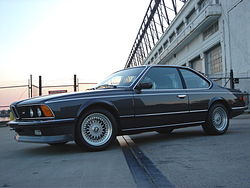BMW E24
 | |
| Manufacturer | BMW |
|---|---|
| Production | 1976 - 1989 86,216 built |
| Predecessor | BMW E9 |
| Successor | BMW E31 |
| Body style(s) | 2 door coupé |
| Layout | FR layout |
| Engine(s) | 2.8L−3.5L I-6 |
| Transmission(s) | 4 or 5 speed manual, 3 or 4 speed automatic |
| Wheelbase | 2626 mm (103.4 in) |
| Length | 4755 mm (187.2 in) |
| Width | 1725 mm (67.9 in) |
| Height | 1365 mm (53.7 in) |
| Curb weight | 1450 kg (3197 lb)−1520 kg (3351 lb) |
| Designer | Paul Bracq |
The BMW E24 automobile platform was the basis for the first production of BMW 6 Series coupé, produced by the German automaker BMW between the 1976 and 1989 model years. Replaced by the E31 chassis 8 Series coupés, the 6 Series name reappeared with the BMW E63 chassis beginning in the 2004 model year. The E24 borrowed heavily from contemporary 5-series cars (E12, later E28).
Model history
The E24 was a replacement for the CS and CSL coupés first produced in 1965. Production started in March 1976 with two models: the 630CS and 633CSi. Originally the bodies were manufactured by Karmann, but production was later taken in-house to BMW.
In July 1978 a more powerful variant, the 635CSi, was introduced (for the time being not available in North America and Japan) that featured as standard a special close-ratio 5-speed gearbox and a black rear spoiler.
In 1979 the carburetted 630CS was replaced with the 628CSi; this car had a fuel injected 2.8L engine taken from the BMW 528i.
In 1982 (Europe) and 1983 (US), the E24 changed slightly, with an improved interior and slightly modified exterior. At the same time, the 635CSi received a new engine, a slightly smaller-bored and longer-stroked 3430 cc six to replace the former 3453 cc engine and became available with a wide-ratio 5-speed or an automatic.
In Europe, 1984 saw the introduction of the M635CSi, essentially an E24 powered by the powerplant of the BMW M1 (the M88, now putting out 286 PS (282 hp/210 kW)). 16" BBS 3 piece wheels and a deeper air dam completed the package. Most M635csi's were equipped with special metric 415 mm wheels requiring Michelin TRX tires.
The 1988 E24s came with ellipsoid headlamps, and were equipped with a single type of bumper. Previous cars had either a European-standard bumper or a larger, reinforced bumper to meet the US standard requiring bumpers to withstand impact at 5 mph (8 km/h) without damage to safety-related components. 1989 was the last year for the E24 with production stopping in April. The replacement for the E24 was the considerably heavier and more complex BMW 8 Series.
North America and Japan
While in most markets several E24 versions were usually available, markets with strict emission control regulations received only a single model (except for the M6 that was later offered additionally). This meant that in North America and Japan, BMW offered the following models :
- 630CSi (MY 1977 through 1978½)
- 633CSi (MY 1978½ through 1984)
- 635CSi (MY 1985 through 1989)
- M6 (MY 1987 through 1989)
In 1977, the 6er was released in the US as the 630CSi. This was a fuel-injected version of the carburetted 630CS available elsewhere. Its 3-litre es and horsepower increased slightly to 182 hp (136 kW). The big difference, however, was torque. Whereas the 3.2 litre had 195 ft·lbf (264 N·m) at 4,000 rpm, the 3.4 litre powerplant managed 214 ft·lbf (290 N·m) at 4,000 rpm.
From model year 1983, North American and Japanese versions benefitted from the technical revisions and changes to the interior introduced elsewhere in spring or summer 1982. Its chassis was now based on the E28 and no longer on the E12. The front and rear suspension was also revised. Later a sel at 4,000 rpm.
From model year 1983, North American and Japanese versions benefitted from the technical revisions and changes to the interior introduced elsewhere in spring or summer 1982. Its chassis was now based on the E28 and no longer on the E12. The front and rear suspension was also revised. Later a self-levelling rear suspension was added to the features list.
The US received its own M series E24 in 1987 but it was called simply M6 and due to emission regulations it came with a reduced 256 hp (191 kW).
In 1988, the US E24 was now available with the newest version of the M30, the 3.4L (first used in the E32 735i). Even though the intake manifold states 3.5 it's technically a 3.4 (3430cc) like the previous 3.4. This engine had an increased compression ratio, and updated Motronics/DME. The result was 208 hp (155 kW) and 225 ft·lbf (305 N·m) torque. In effect, this engine was identical to the catalyzed version newly available in Germany and other markets.




![Validate my RSS feed [Valid RSS]](valid-rss-rogers.png)















































































ไม่มีความคิดเห็น:
แสดงความคิดเห็น